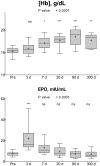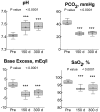Lack of acclimatization to chronic hypoxia in humans in the Antarctica
- PMID: 29273712
- PMCID: PMC5741743
- DOI: 10.1038/s41598-017-18212-1
Lack of acclimatization to chronic hypoxia in humans in the Antarctica
Erratum in
-
Author Correction: Lack of acclimatization to chronic hypoxia in humans in the Antarctica.Sci Rep. 2018 May 1;8(1):7063. doi: 10.1038/s41598-018-24804-2. Sci Rep. 2018. PMID: 29717142 Free PMC article.
Abstract
The study was carried out at Concordia Station (Antarctic Plateau). The aim was to investigate the respiratory and haematological responses to hypoxia in healthy subjects living at constant altitude. Thirteen men and women (34.1 ± 3.1 years) were exposed for 10 months to hypobaric hypoxia (oxygen level equivalent to 3800 m asl). These unique conditions enable a greater accuracy of monitoring human responses to chronic hypoxia than can be achieved elsewhere. Blood haemoglobin and erythropoietin concentrations were determined at sea level (Pre), and after 3, 7, 20, 90 and 300 days at altitude. Blood gas analysis, base excess and arterial oxygen saturation were measured at Pre, and after 150 and 300 days at altitude. Erythropoietin returned quickly to baseline level after a transient increase in the first days. Blood haemoglobin concentration started increasing at day 7 and remained markedly higher for the entire duration of the mission. At day 150 the blood carbon dioxide partial pressure was markedly reduced, and consequently blood pH remained higher at negative base excess until day 300. The arterial oxygen saturation remained lower than Pre throughout. In conclusion, humans display little capacity of hypoxia acclimatization even after ten months of constant exposure to low oxygen partial pressure.
Conflict of interest statement
The authors declare that they have no competing interests.
Figures


Similar articles
-
Long-term exposure to intermittent hypoxia results in increased hemoglobin mass, reduced plasma volume, and elevated erythropoietin plasma levels in man.Eur J Appl Physiol. 2003 Feb;88(6):535-43. doi: 10.1007/s00421-002-0732-z. Epub 2002 Dec 14. Eur J Appl Physiol. 2003. PMID: 12560952 Clinical Trial.
-
Long-term intermittent hypoxia increases O2-transport capacity but not VO2max.High Alt Med Biol. 2007 Fall;8(3):225-35. doi: 10.1089/ham.2007.8309. High Alt Med Biol. 2007. PMID: 17824823 Clinical Trial.
-
Effects of chronic hypoxia and exercise on plasma erythropoietin in high-altitude residents.J Appl Physiol (1985). 1993 Apr;74(4):1874-8. doi: 10.1152/jappl.1993.74.4.1874. J Appl Physiol (1985). 1993. PMID: 8514706
-
Current trends in altitude training.Sports Med. 2001;31(4):249-65. doi: 10.2165/00007256-200131040-00002. Sports Med. 2001. PMID: 11310547 Review.
-
High-altitude training. Aspects of haematological adaptation.Sports Med. 1992 Nov;14(5):289-303. doi: 10.2165/00007256-199214050-00002. Sports Med. 1992. PMID: 1439397 Review.
Cited by
-
Impact of High-Altitude Hypoxia on Bone Defect Repair: A Review of Molecular Mechanisms and Therapeutic Implications.Front Med (Lausanne). 2022 May 10;9:842800. doi: 10.3389/fmed.2022.842800. eCollection 2022. Front Med (Lausanne). 2022. PMID: 35620712 Free PMC article. Review.
-
Exploratory RNA-seq analysis in healthy subjects reveals vulnerability to viral infections during a 12- month period of isolation and confinement.Brain Behav Immun Health. 2020 Sep 24;9:100145. doi: 10.1016/j.bbih.2020.100145. eCollection 2020 Dec. Brain Behav Immun Health. 2020. PMID: 34589891 Free PMC article.
-
COVID-19-associated cardiovascular morbidity in older adults: a position paper from the Italian Society of Cardiovascular Researches.Geroscience. 2020 Aug;42(4):1021-1049. doi: 10.1007/s11357-020-00198-w. Epub 2020 May 20. Geroscience. 2020. PMID: 32430627 Free PMC article. Review.
-
Long-Term Environmental Hypoxia Exposure and Haematopoietic Prolyl Hydroxylase-1 Deletion Do Not Impact Experimental Crohn's Like Ileitis.Biology (Basel). 2021 Sep 8;10(9):887. doi: 10.3390/biology10090887. Biology (Basel). 2021. PMID: 34571764 Free PMC article.
-
Enhanced-Precision Measurement of Glutathionyl Hemoglobin by MALDI-ToF MS.Molecules. 2023 Jan 4;28(2):497. doi: 10.3390/molecules28020497. Molecules. 2023. PMID: 36677554 Free PMC article.
References
-
- Kanwisher J. Oxygen in Antarctic Air. Tellus. 1957;9:137–138. doi: 10.3402/tellusa.v9i1.9050. - DOI
Publication types
MeSH terms
Substances
LinkOut - more resources
Full Text Sources
Other Literature Sources

